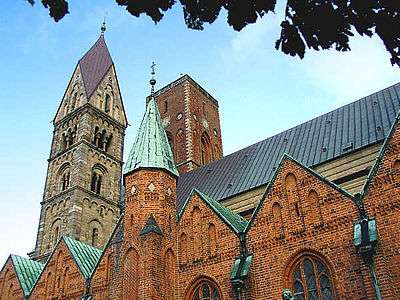Ancient Diocese of Ribe
| Diocese of Ribe Dioecesis Ripensis Ribe Stift | |
|---|---|
|
Ribe Cathedral, seat of the bishop of Ribe. | |
| Location | |
| Country | Denmark |
| Ecclesiastical province | Lund |
| Metropolitan | Archdiocese of Lund |
| Information | |
| Denomination | Roman Catholic |
| Sui iuris church | Latin Church |
| Rite | Roman Rite |
| Established | 948 |
| Dissolved | 1536 |
| Cathedral | Ribe Cathedral |
The former Roman Catholic diocese of Ribe (29 deaneries, 278 parishes) consisted of the modern Danish Provinces of Ribe, Vejle and Ringkøbing, and part of Southern Jutland. The first church built at Ribe was founded by Saint Ansgar in 860, served by his biographer and successor, Saint Rembert, and destroyed during the heathen reaction after the latter's death in 888. It was rebuilt towards 948, in which year Saint Leofdag, first Bishop of Ribe, was consecrated by Archbishop Adaldag of Hamburg, probably at the Council of Ingelheim (Germany), which the Jutlandic bishops attended. Leofdag is said to have been martyred by the heathen at Ribe. Until the death of his third known successor Vale (1044–59) the bishops of Ribe, Schleswig, and Aarhus wandered about Jutland on missionary tours.
In 1060, Jutland north of the Kongeå was divided into the four Dioceses of Ribe, Aarhus, Viborg and Vestervig (Børglum). Originally the diocese was a suffragan of the Archdiocese of Hamburg-Bremen until 1104, when the Diocese of Lund, elevated to a new archdiocese, became its metropolitan. Bishop Thure (1125–34) began the construction of the fine Cathedral of Our Lady at Ribe, which was finished under Bishop Elias (1142–66), who founded the chapter in 1145. His successor Radulf (1170–71), an Englishman and chancellor to King Valdemar I, translated to the cathedral the relics of Saint Leofdag, who was never formally canonized. He began the foundation of the Cistercian Løgum Abbey (Løgumkloster; Locus Dei) in the present Løgumkloster in Northern Schleswig, which was completed by his successor Stephen (1173–77), formerly abbot of Herrevad Abbey (in Scania). Bishop Omer (1178–1204) reduced the number of the canons of Ribe to twelve. Bishop Christian II (1288–1313) in 1298 greatly enriched the cathedral school, which had been founded in 1145. Bishops Eskil (1388–1409) and Henry Stangberg (1455–65) published synodal statutes with a view to reforming both clergy and laity.
Ivar Munk was elected bishop in 1499 but not consecrated till 1513. Although he was unable to prevent Duke Christian from protestantizing Northern Schleswig, he kept Lutheranism out of the rest of his diocese. Ivar Munk opposed Christian's election as King Christian III of Denmark in 1533, being however compelled as a privy councillor for Jutland to join that monarch's party, Ivar Munk resigned his bishopric in 1534 in favour of his nephew, Olaf Munk. The bishop's palace at Ribe was bestowed upon Ivar Munk and there he died in 1539. Like the other Danish bishops Olaf Munk was imprisoned on 12 August 1536. When released he had to promise to marry as well as to comply with the conditions imposed upon all the Danish bishops. On the fulfilment of his promise the premises and lands of the former Tvis Abbey were bestowed upon him. He was later readmitted to the privy council, and he lived the life of a rich nobleman until his death in 1569.
Ribe Cathedral (restored in 1904), a Romanesque building with Gothic additions and a tower dating from 1440, contained besides the shrine of Saint Leofdag a chapel dedicated to Saint Lambert, which was a great centre for pilgrimages. Saint Lambert was the patron of Ribe as well as of Liège in Belgium, and his cultus at Ribe is doubtless due to the trading connection between that city and the Low Countries. The abbey church of Løgum Abbey, the Romanesque churches near Ribe, like the cathedral built of volcanic stone brought from Andernach on the Rhine, and the earliest Christian monument in Denmark, the great carved stone set up by King Harold Bluetooth near the funeral mounds of his parents, King Gorm the Old (d. 940) and Queen Thyra Danebod (d. 945) at Jellinge near Veile, are all memorials of the Roman Catholic past of the Diocese of Ribe.
The cathedral chapter consisted of four prelates and twenty-one prebendaries (twelve resident). There were eight minor canons and nearly fifty chaplains.
In the city of Ribe there were also the Benedictine nunnery of St. Nicholas (founded before 1215), a Franciscan friary and the Dominican St. Catherine's Priory, both dating from 1259, a hospital of the Holy Ghost and a commandery of the Knights of St. John of Jerusalem, both dating from about 1300.
Elsewhere in the diocese were the Cistercian monasteries of Tvis Abbey, near Holstebro (founded by Prince Buris in 1163), of Løgum Abbey and of Seem Abbey, the last having been Benedictine till 1171. There were Benedictine nunneries at Gudum and at Stubber, a Dominican priory at Vejle and a Franciscan friary at Kolding.
In 1912 there were Catholic churches, schools and hospitals at Esbjerg, Kolding, Fredericia and Vejle.
